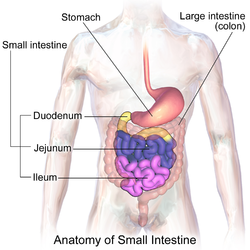Small intestine
| Small Intestine | |
|---|---|

Diagram showing the small intestine and surrounding structures
|
|
| Details | |
| Artery | Superior mesenteric artery |
| Vein | Hepatic portal vein |
| Nerve | Celiac ganglia, vagus |
| Lymph | Intestinal lymph trunk |
| Identifiers | |
| Latin | Intestinum tenue |
| MeSH | A03.556.124.684 |
| Code | 4453467 |
| Dorlands /Elsevier |
Small intestine r |
| TA | A05.6.01.001 |
| FMA | 7200 |
|
Anatomical terminology
[]
|
|
The small intestine or small bowel is the part of the gastrointestinal tract between the stomach and the large intestine, and is where most of the end absorption of food takes place. The small intestine has three distinct regions – the duodenum, jejunum, and ileum. The duodenum receives bile and pancreatic juice through the pancreatic duct, controlled by the sphincter of Oddi. The primary function of the small intestine is the absorption of nutrients and minerals from food.
This article is primarily about the human gastrointestinal tract. The information about its processes is directly applicable to most placental mammals. A major exception to this is the digestive process in ruminants – notably cows. In invertebrates such as worms, the term "large intestine" is often used to describe the entire gastrointestinal tract.
The length of the small intestine can vary greatly, from as short as 2.75 m (9.0 ft) to as long as 10.49 m (34.4 ft). The average length in a living person is 3m-5m. The length depends both on how tall the person is and how the length is measured. Taller people generally have a longer small intestine and measurements are generally longer after death and when the bowel is empty.
It is approximately 2.5–3 cm (1 inch) in diameter. On abdominal X-rays, the small intestine is considered to be abnormally dilated when the diameter exceeds 3cm. On CT scans, a diameter of over 2.5 cm is considered abnormally dilated. The surface area of the human small intestinal mucosa, due to enlargement caused by folds, villi and microvilli, averages 30 square meters.
...
Wikipedia
